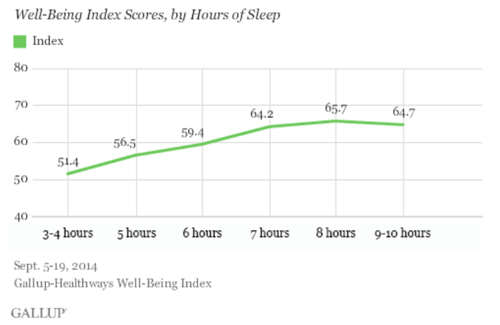
How Employers Can Fight Workplace Fatigue
Have you noticed your employees coming in late, coming in sick frequently or mentioning they’re not getting enough rest? Have you also noticed the same employees experiencing low productivity or job burnout? It’s possible these employees are suffering from workplace fatigue.
According to the GCC Insights report by Global Corporate Challenge (GCC), an average employee loses around 57.5 days per year due to physically showing up to work even though they’re not physically or mentally well enough to do their job.

This problem – known as presenteeism – is often much more costly to an employer than if the employee didn’t come to work at all. While there are several causes that can lead to presenteeism, fatigue is among the most common.
In this article, we’ll discuss how employers can minimize workplace fatigue, reduce related costs and improve their employees’ quality of life.
What Does Workplace Fatigue Look Like?
Workplace fatigue is defined by the National Safety Council as “the feelings of tiredness, sleepiness, reduced energy and increased effort needed to perform tasks at a desired level.” This condition manifests for a variety of reasons, including long days, overworking on stressful projects or performing repetitive tasks for extended periods of time.
Because of their lack of energy, people with workplace fatigue often show a trend of declining job performance. There’s a good chance many of us work even if we lack enough sleep, as reports show more than 43% of workers are sleep deprived, and exhibit symptoms like:
- Slowed cognitive reflexes
- Irritability
- Lack of motivation
- Headaches
- Poor immune system
The bad news: Without enough rest, a tired worker puts their safety and productivity at risk.
The good news: fatigue is reversible. The more hours per sleep a person gets per night, according to a Gallup study, the more positive effect it has on their overall health and wellbeing.

Mental Health
Long hours can also negatively bear down upon an employee’s mental health along with causing physical fatigue. Overworking can exacerbate underlying mental health disorders, such as:
- Generalized Anxiety Disorder (GAD): Symptoms include excessive anxiety and worry about a range of concerns such as world events, finances or health.
- Panic Disorder (PD): Symptoms include recurrent, unexpected panic attacks that are associated with a persistent concern about having another attack.
- Social Anxiety Disorder: Symptoms include extreme and persistent social or performance anxiety that causes significant distress.
- Obsessive-Compulsive Disorder (OCD): Symptoms include recurrent intrusive thoughts that prompt the performance of often repetitive, particular and neutralizing rituals.
How Work Worsens The Problem
Now, before employers go and tell their workers to simply get more sleep at home, it’s important to take a step back and consider the ways the business could be exacerbating the problem.
Although it may manifest differently depending on the industry or role of the employee, the fact is that anyone can experience symptoms of workplace fatigue – physical, mental or both.
There are several major factors contributing to workplace fatigue across industries.
Commuting
For some, just getting to the office can be more fatiguing than the job itself, reported by Time. While some people commute as little as 10 minutes to their office, others might travel as much as three to four hours each way. Those long days don’t allow for much time to decompress or recuperate.
Working Long Hours
If the commute isn’t enough pressure, work itself is a significant source of stress for 65% of U.S. employees, according to a report by the American Psychological Association Center for Organizational Excellence.
Working long hours can indeed be counterproductive; data shows no correlation between overworking and increased productivity, as Harvard Business Review discovered.
Working long hours and performing monotonous tasks exhaust employees and takes a negative toll on their physical health, according to the National Safety Council. Some of the most exhausting jobs require extended periods of attention and consume more energy than you might realize, such as stationary work on a computer or performing repetitive tasks like operating levers on a forklift.
Uncomfortable Work Environments
While the work itself is stressful, work environments also play a subtle factor. Uncomfortable work conditions such as inadequate lighting, hot or cold temperatures and excessively loud noises can exhaust employees and prevent them from focusing on their job.
Take active measures to address these issues by talking to your staff. Ask them what bothers them at work, listen and invest in fixes to any issues they have with their workspace. They’ll appreciate it and you’ll make the workplace more welcoming for everyone.
Caffeine Consumption
Some may try to find alleviate the stress of work with beverages offered at the office. For example, daily consumption of excessive amounts of coffee may lead to increased levels of anxiety, high blood pressure and frequent headaches.
If you believe there’s a problem of drinking an excessive amount of coffee among your workforce, it may be worth sharing the negative effects of consuming too much caffeine with your team.
How Employers Can Help
For employees, any combination of not getting enough sleep, working long hours, commuting long distances, not getting help for underlying mental health disorders or consuming excessive amounts of caffeine can create a perfect storm for workplace fatigue and presenteeism.
Employers need to be aware of these possible hazards that workers face every day and look out for signs of fatigue so they can take action before productivity falters or an accident occurs on the job.
Some helpful ways for employers to eliminate workplace fatigue include:
- Allowing frequent and adequate rest breaks
- Being conscious of the environment your employees are working in
- Purchasing a sleep pod for your office
- Discussing whether occasional remote work is an option for long commuters
- Developing a work culture that recognizes overworking is harmful to the bottom line
- Ensuring workers with repetitious, monotonous tasks take occasional breaks
- Providing special care and help workers who exhibit any mental health issues
By taking the time to find out the reasons why someone is experiencing a reoccurring, severe lack of energy or low performance at work, you’re taking the first steps towards fixing the problem.
At IPMG, we take employee wellbeing seriously. As part of our Nurse Case Management services, we provide employees in need with a multidisciplinary team of specialists and absence management solutions to address the underlying factors causing problems like fatigue so they can get the help they require as soon as possible.
If you need resources or are interested in discussing how to reduce workplace fatigue for your business, learn more about how we can help here.


